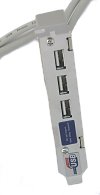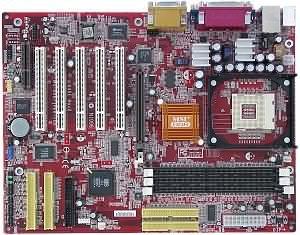MSI 645E Max2-LRU (SiS645DX) Mainboard
|

The board packed in a new box offers abundance of functions,
which is typical of this company these days.
Accessories:
- Package: cardboard box laminated with yellow and green
lustrous coating;
- Documentation: user manual in English;
- Cables: 2 ATA66/100/133 and FDD;
- Bracket with 4 USB ports;

- S-Bracket;

- D-Bracket;

- 2 CDs containing:
- drivers;
- DirectX 8.1;
- Adobe Acrobat Reader;
- VNC;
- 3Deep;
- PC-Cillin 2000;
- X-Setup;
- MSI DVD;
- MSI Fuzzy Logic (for automatic CPU overclocking);
- MSI GoodMem (for optimization of system memory);
- MSI InfoView (displays information in system devices);
- MSI i-Speeder (for optimization of the Internet access
and monitoring of network connections);
- MSI Live Update 2 (for automatic drivers and BIOS
updates);
- MSI LockBox (to restrict a computer access);
- MSI PCAlert III (system monitoring);
- MSI SecureDoc (file encryption);
- MSI SmartKey.

The layout is not devoid of the usual drawbacks: the CD-In
is near the back panel, when a video card is installed it's
difficult to handle the memory modules and cables in the IDE
connectors, and the IDE RAID and FDD connectors are behind
the PCI slots. But it's not difficult to reach the only jumper
when the board is already installed. Its function is shown
on the textolite.
The 2-channel switching voltage regulator incorporates 4 capacitors
of 2200 uF and 7 of 1500 uF.
The following controllers are integrated:
- audio controller based on the chipset's capabilities
and Avance Logic ALC650 AC'97 codec supporting 5.1 audio
systems and having an output for front audio connectors;
- network controller based on the Realtek RTL8100L;
- IDE RAID controller based on the AChip ATP865-A chip
supporting RAID 0 and 1 via the ATA133 protocol;
- USB 2.0 bus controller based on the NEC D720100AS1 chip.
Non-unsoldered connectors: none. The system monitoring
is supported by the Winbond W83697HF chip. What is controlled:
- processor voltage, +3.3, +5 and +-12 V and VBAT;
- speed of 2 fans;
- temperatures of the processor (a built-in sensor)
and the board (a built-in sensor).
There are 2 connectors for adjustable connection of fans.
Brief characteristics of the board: memory slots - 3
DDR SDRAM; expansion slots - AGP/ 5 PCI/ CNR; I/O ports -
2 COM/ LPT/ 2 PS/2/ 4 USB 2.0/ 4 USB 1.1 (the chipset supports
up to 6 ports); dimensions - 305x245 mm.

Adjustment can be carried out with:
| jumpers and switches |
Jumper to clear up the CMOS |
|
| BIOS based on v.3.31a from
AMI |
Setup of memory timings |
+ |
CAS Latency, Timing Setting Mode, MA
1T/2T Select, Host to Memory Latency |
| Setup of memory frequency |
+ |
CPU:DRAM = 1:1, 3:4, 3:5 (at the FSB
from 100 to 132 MHz); 4:3, 1:1, 4:5 (at the FSB from
133 to 160 MHz); Auto (at the FSB over 160 MHz) |
| Setup of AGP bus |
- |
|
| Setup of PCI bus |
- |
|
| Changeable scaler of AGP and PCI buses |
- |
|
| Manual assignment of interrupts |
+ |
|
| Changeable FSB frequency |
+ |
100 -200 MHz in 1MHz steps |
| Changeable CPU multiplier |
+ |
x8-x50 |
| Changeable core voltage |
+ |
1.475-1.6 V in 0.025V steps |
| Changeable memory voltage |
+ |
2.5, 2.6, 2.7 and 2.8 V |
| Changeable chipset voltage |
- |
|
| Changeable AGP bus voltage |
- |
|
We used the latest available version of the BIOS - BIOS 1.0.
A fairly good set of components and rich functions coupled
with an excellent speed obtained with the DDR333 memory and
a notable overclocking reserve make this model a tempting
offer for many.
Test results:
Write a comment below. No registration needed!
|
|






